Microsoft ends support for Internet Explorer on June 16, 2022.
We recommend using one of the browsers listed below.
- Microsoft Edge(Latest version)
- Mozilla Firefox(Latest version)
- Google Chrome(Latest version)
- Apple Safari(Latest version)
Please contact your browser provider for download and installation instructions.
March 27, 2015
Nippon Telegraph and Telephone Corporation
Oki Electric Industry Co., Ltd.
Joint development of PON system with enhanced transmission capacity, distance and split ratio using wavelength and time division multiplexing technology - Report on the world's first successful field demonstration of a wide-area optical access network wit
Nippon Telegraph and Telephone Corporation (NTT, Chiyoda-ku, Tokyo, CEO: Hiroo Unoura) and Oki Electric Industry Co., Ltd. (OKI, Minato-ku, Tokyo, President Hideichi Kawasaki) have jointly developed a new technology that combines the PON*1 technology with the wavelength and time division multiplexing technology - "WDM/TDM-PON technology*2." The two companies have successfully demonstrated the jointly developed optical access system featuring the WDM/TDM-PON technology in ultra-large capacity transmission at 40Gbit/s over a 40km distance servicing 1024 users. In other words, this new optical access system enables a transmission capacity of 40 times that of the existing system while accommodating 32 times more users.
Part of the project accomplishments will be presented in a postdeadline paper*3 at an international conference on optical fiber communications, OFC2015 (Optical Fiber Communication Conference 2015: Los Angeles, U.S.A. :March 22-26, 2015), on March 26 (PST).
1.Background
This research and development project was contracted to NTT and OKI by the Ministry of Internal Affairs and Communications under a research contract titled "Research and development of wide area optical access networks." Research and development in the field of next generation optical access network systems has been tasked with a major objective of achieving an enhanced transmission capacity in order to handle ever-increasing traffic of broadband services users. Another important objective of R&D has been to achieve a longer transmission distance and increase the number of users supported per system. This will make possible efficient operation and lower power consumption of a network as a whole as a result of overall reduction of the number of central offices as well as the number of system equipment located in such central offices. Thus, further technological innovation, innovation that pushes the envelope of the conventional time division multiplexing (TDM-) PON technology, is necessary to allow for a larger transmission capacity, wider coverage and an increased per system number of users.
To this end, NTT Access Network Service Systems Laboratories (NTT labs.) and OKI have devoted their efforts in developing WDM/TDM-PON technology (Figure 1), a combination of the conventional TDM-PON technology with the Wavelength Division Multiplexing (WDM) technology popularly used in Core/Mero networks for transmission over long distances. The WDM/TDM-PON technology has combined advantages; it efficiently accommodates multiple users by using the TDM-PON technology while largely enhancing the total bandwidth and the transmission capability over longer distances with smaller optical power loss by using the WDM.
2.Project Details and Accomplishments
The jointly developed WDM/TDM-PON technology consists of (1) wavelength-tunable burst-mode optical transceivers*4, (2) a wavelength multiplexed burst-mode optical amplifier and (3) a wavelength tuning protocol.
(1)Wavelength-tunable burst-mode optical transceivers [NTT labs and OKI]
In a WDM/TDM-PON, each Optical Network Unit (ONU) on the customer premises communicates at one of four pre-determined wavelengths. Using different ONUs for each of these wavelengths would increase management cost and the risk of improper connection. A solution is to equip the ONU with an optical transceiver capable of tuning to different wavelengths (i.e. colorless). Two types of wavelength-tunable burst-mode optical transceiver have been developed in this project (Figure 2).
(2)Wavelength multiplexed bust-mode optical amplifier [NTT]
Achieving a 40km transmission distance and a split ratio of 1-to-1024 over a WDM/TDM-PON requires an optical amplification technology*5 that can economically amplify wavelength multiplexed upstream burst signals. Also important is to equalize the signal output power level for upstream bursts and to expand the input dynamic range*6. In this project we adopted Semiconductor Optical Amplifiers (SOAs) as a gain medium*7 for the purpose of compactifying and economizing our system equipment. We also developed an Automatic gain control (AGC) technology that enables high-speed control over SOA gain for further economization through part number reduction (Figure 3).
(3)Wavelength tuning protocol [NTT labs. and OKI]
The maximum bandwidth per a wavelength of this WDM/TDM-PON system is 10Gbps (10Gbps*4 wavelengths = 40Gbps). Frame losses can occur when the aggregated traffic of the ONUs communicating at the same wavelength exceeds 10Gbps. In order to address this issue, a wavelength tuning protocol has been developed that allows for the switching of the ONU's wavelength to any one of the other three wavelengths at which there is less traffic. The tuning can be performed during system operation and while tuning, transmission of frames is suspended and frames are buffered at both carrier's central office equipment (Optical Line Terminal; OLT) and the ONU. Upon a successful completion of wavelength tuning, transmission of buffered frames will resume thereby preventing any frame loss across the tuning process.
NTT labs. and OKI conducted a world's first field demonstration with OLTs and ONUs implementing the aforementioned newly developed technology and optical amplifiers. The field demonstration took place in Sapporo, Hokkaido, connecting multiple NTT East buildings with optical fiber cables and using a testbed*8 of a wide-area subscriber optical network over a 40km transmission distance and with the split ratio of 1-to-1024 (Figure 4,5). The demonstration successfully showed for the first time that with the system's favorable transmission characteristics of the total upstream and downstream bandwidth of 40Gbps and capability to switch wavelengths without frame losses, the OLT can save energy consumption by reducing the number of working wavelengths when the total traffic volume becomes low.
The accomplishments made by this project will be presented to and adopted by the ITU-T G.989*9 (commonly known as NG-PON2) standardization committee.
3.Future Outlook
NTT lab and OKI will work to enhance the reliability of the "WDM/TDM-PON technology" and miniaturize the system equipment. The two companies will also share and appeal the accomplishments we have made to collaborate with organizations in and outside Japan.
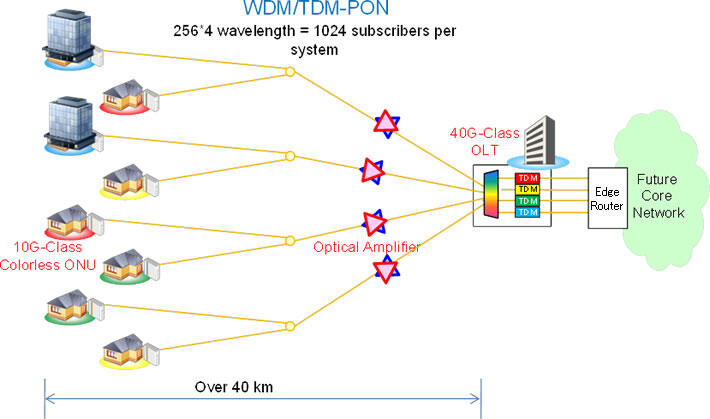 Figure 1 Concept of WDM/TDM-PON
Figure 1 Concept of WDM/TDM-PON
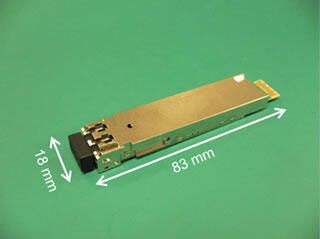 (a)OKI transceiver
(a)OKI transceiver
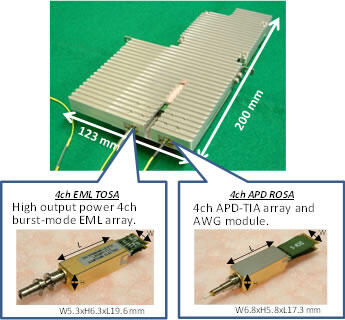 (b)NTT transceiver
(b)NTT transceiver
Figure 2 Wavelength-Tunable Burst-Mode Optical Transceivers (for ONU)
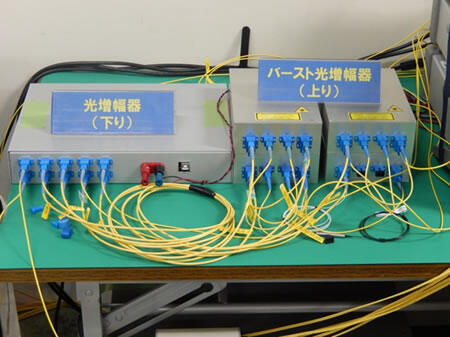 Figure 3 Burst-Mode Optical Amplifier
Figure 3 Burst-Mode Optical Amplifier
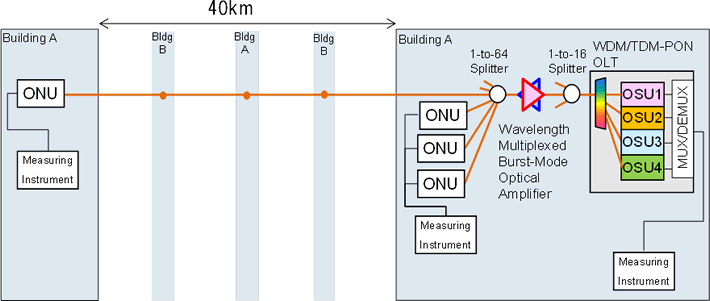 Figure 4 Field Demonstration Setup
Figure 4 Field Demonstration Setup
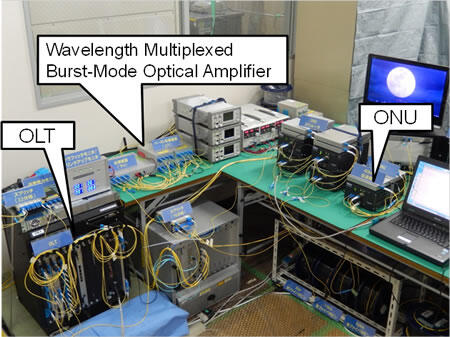 Figure 5 Scenes from Field Demonstration
Figure 5 Scenes from Field Demonstration
Glossary
*1PON (Passive Optical Network):
An optical access architecture in which multiple optical fibers are connected by a passive (i.e. unpowered) splitter called an optical coupler.
*2WDM/TDM-PON:
Wavelength Division Multiplexing (WDM)/Time Division Multiplexing (TDM) PON. A hybrid access system technology that combines features of TDM-PON where transmission is multiplexed in the time domain enabling a data rate of 10Gbps with WDM-PON where the allocation of a total bandwidth of 40Gbps is possible through multiplexing in the wavelength domain. The colorless ONU's wavelength tunability allows for flexible switching of wavelengths in the system for greater resource efficiency.
*3Postdeadline paper:
Postdeadline papers are papers received by conferences after the submission deadline. Postdeadline papers are accepted after the normal deadline to give conference participants an opportunity to hear new and significant results in rapidly advancing areas. The papers to be presented are refereed and selected during the conference, and only papers judged to be excellent and compelling are accepted for presentation in postdeadline sessions.
*4Burst signal:
Intermittent signal. In a PON system, signals from each user are transmitted in bursts to avoid collision on the up link (link from a user to the communication carrier's building).
*5Optical amplification technology:
Technology that directly amplifies one or more optical signals without converging them into electrical signals.
*6Dynamic range:
The ratio between the minimum and maximum signal level that can be handled. The bigger the dynamic range of an optical amplifier is, the more users can be accommodated.
*7Gain medium:
Material used in an optical amplifier to amplify optical signals. For example, optical fibers doped with special material and semiconductors are used for the purpose.
*8Testbed:
Experiment environment that closely mimics real operation conditions but is configured for testing of technology in the research and/or development stages.
*9ITU-T G.989 series:
Recommendations for multi-wavelength 40-Gigabit-capable passive optical networks by ITU-T(International Telecommunication Union Telecommunication Standardization Sector). Commonly known as "NG-PON2 (Next Generation Passive Optical Network Phase 2)".
Press contact:
Nippon Telegraph and Telephone Corporation
Information Network Laboratory Group
Planning Department, Public Relations Section
E-mail:inlg-pr@lab.ntt.co.jp
Oki Electric Industry Co.,Ltd.
Public Relations Division
Phone: +81-3-3501-3835
E-mail:press@oki.com
Information is current as of the date of issue of the individual press release.
Please be advised that information may be outdated after that point.
NTT STORY
WEB media that thinks about the future with NTT











